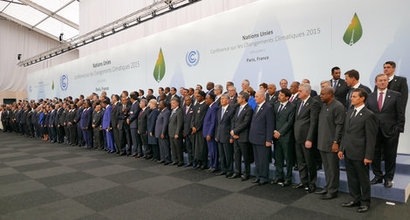
The Talanoa Dialogue (‘Talanoa’ is a Fijian word meaning an inclusive dialogue) is an important international conversation that aims to help countries increase their climate pledges in order to meet the goals of the Paris Agreement. As part of the Paris Agreement, countries decided to pursue efforts to limit temperature rise to 1.5°C. Yet the contributions proposed at the Paris talks, including the EU’s pledge to reduce emissions by at least 40 percent by 2030, would only keep global warming to around 3°C at best, far above the Paris objectives. The Talanoa Dialogue, running throughout 2018, aims to build trust and boost ambition, and thus create the necessary dynamic which will help countries revise and increase their current commitments by 2020. It is a core part of the five-year review cycles agreed in Paris to ramp up ambition over time.
As agreed in Paris, by 2020 all countries are required to review and resubmit their contributions to the United Nations Convention on Climate Change. The EU has the potential to become a global leader in this process, but this depends on whether it is prepared to increase its own climate targets, which are currently inadequate.
The Climate Action Network (CAN) believe that Environment Ministers preparing the EU’s contribution to the dialogue this week need to outline a process to put in place more ambitious targets by 2020. A recent study by the Oeko Institute shows that for the EU to contribute its fair share to keeping global temperature rise to 2°C, it would have to set itself an emission reduction target of 55 percent for 2030. To limit temperature rise to 1.5°C, the EU should be looking at a target in the range of -65%.
“The Talanoa Dialogue is a golden opportunity to close the huge gap between the goals of the Paris Agreement and what is happening in reality” said Wendel Trio, Director of Climate Action Network (CAN). “EU Ministers need to show that they are taking this process seriously. They all need to recognise that the EU’s current climate targets are inadequate and agree on a process to revise and increase them by 2020. The urgency has never been greater, but neither have the benefits for people and the economy.”
Some decision makers clearly understand that bold commitments are needed. On 2 March, Dutch Prime Minister Mark Rutte called upon the EU to increase its climate target from at least 40 to 55 percent emission cuts by 2030. On 29 March, France and Germany published a joint statement calling upon the EU to quickly review whether the target should be raised.
On 22 March, Europe’s Heads of State and Government called upon the European Commission to urgently put forward a draft of a new EU long-term climate strategy in accordance with the Paris Agreement. The new strategy will have to clearly lay out pathways for how the bloc will contribute to efforts to limit temperature rise to 1.5°C, which will undoubtedly indicate a need to revise the EU’s current climate commitments.
The European Parliament calls for the strategy to deliver net zero emissions by 2050 at the latest, within the framework of the currently negotiated Governance Regulation.
A higher climate target for 2030 will help the EU speed up the transition away from fossil fuels and other sources of carbon emissions to 100 percent renewables by 2050 at the latest. This transition brings numerous benefits, not only for the climate, but also for health, employment and the economy, as the price of green energy falls.
Going for a higher climate target would help restore Europe’s global climate leadership. In the last few years the pace of emission cuts has been slower in Europe than in other countries. In 2017, the EU ETS emissions rose for the first time in seven years. In addition, investments in renewable energy have been shrinking in Europe, while they are on the rise globally. With the current level of ambition, Europe risks missing the ongoing energy revolution and lagging behind other leading economies for decades.
For additional information:

